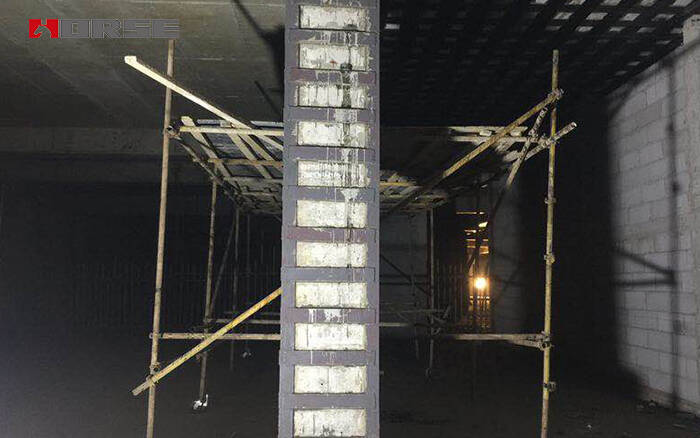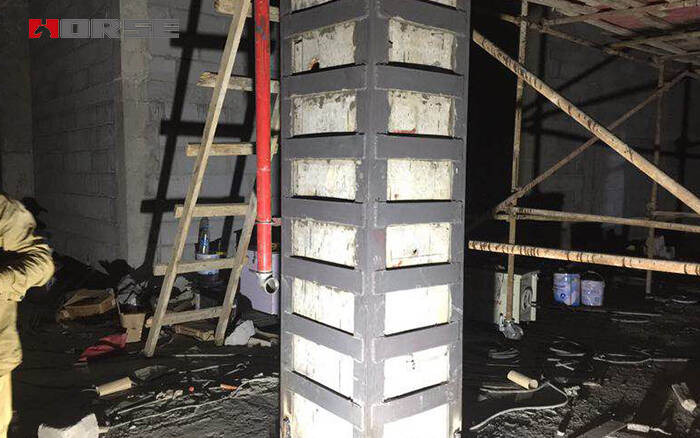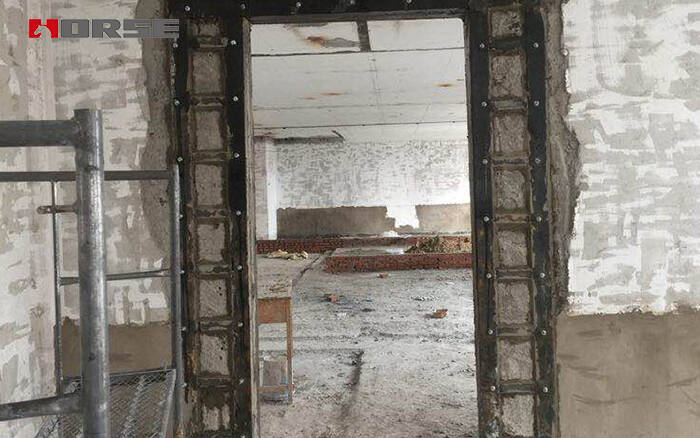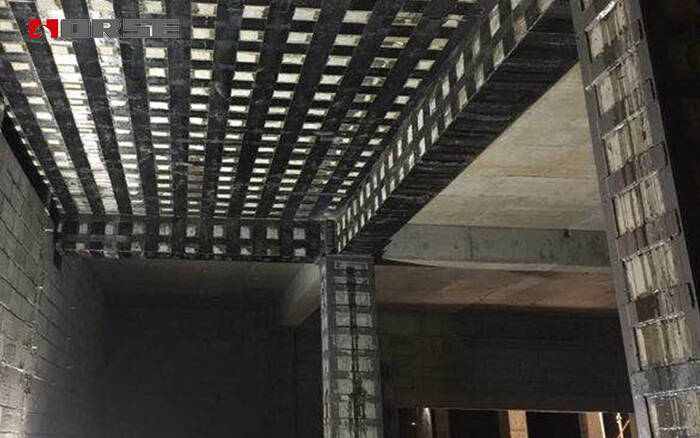تقوية الخرسانة المسلحة باستخدام صفيحة فولاذية خارجية
لاصق الصفائح الفولاذية
يعمل تعزيز الصفائح الفولاذية على تحسين قدرة تحمل الهيكل من خلال العمل المشترك بين الصفائح الفولاذية المقواة بالعمود والمكون الأصلي، كما يعمل على تقوية القص ومقاومة الزلازل والاستقرار، ويحسن حالة الإجهاد.

نظرة عامة على المشروع
هذا المشروع هو مشروع تسليح المباني ضد الزلازل، بمساحة بناء إجمالية تبلغ 16892 مترًا مربعًا، ونوع الهيكل من الطوب الخرساني. يتكون هذا التسليح بشكل رئيسي من الجدران الداخلية والخارجية، والأرضيات، والأعمدة الإنشائية، وإصلاح الشقوق في النوافذ والفتحات والجدران. بعد تسليح المشروع، لا تقل مدة خدمته اللاحقة عن ثلاثين أو أربعين عامًا. درجة سلامة الهيكل: الدرجة الثانية؛ التحصين الزلزالي: الفئة ب؛ شدة التحصين الزلزالي: 7 درجات، المجموعة الأولى: 0.10 جي، مقياس الزلازل: 8 درجات، المكون: الدرجة الثالثة غير الزلزالية، عمق التجمد القياسي: 0.73 متر، ضغط الرياح الأساسي: 0.50 كيلو نيوتن/متر مربع، ضغط الثلج الأساسي: 0.35 كيلو نيوتن/متر مربع، جودة البناء: الدرجة ب.
خصائص بناء التسليح بصفائح الفولاذ الملتصقة
بالمقارنة مع طرق التعزيز الأخرى، تتميز طريقة الفولاذ الملتصق بالهياكل بالعديد من المزايا الفريدة والطابع المتقدم. تتميز بقوة التصاق عالية، وقوتها بعد المعالجة أعلى بكثير من قوة المكون الأصلي. كما تتميز بمقاومة جيدة للماء ومقاومة متوسطة، وخصائص فيزيائية وميكانيكية ممتازة. الإجهاد على وصلات المكونات المثبتة والملحمة يكون موحدًا، ولا ينتج عنه ظاهرة تركيز الإجهاد، كما تتميز بمقاومة التعب والتشقق والسلامة الجيدة. يتميز هذا النموذج بتكنولوجيا بسيطة، وسهولة في التشغيل، وسرعة بناء عالية، وكفاءة عالية، وفترة بناء قصيرة، وتكلفة منخفضة، وتأثير جيد.

نطاق التطبيق
تُطبق طريقة تسليح الفولاذ المُلصق على العناصر التي تتحمل أحمالًا ساكنة، مثل الانحناء والشد والقص وغيرها من المكونات. ويتمثل نطاق التطبيق المحدد فيما يلي:
1) كسر نقطة لحام قضيب التسليح، وتعزيز تسليح التسرب أثناء البناء.
2) عدم وصول مستوى متانة الهيكل أو المكون إلى المستوى المطلوب، مما يُعزز قوة الهيكل.
3) التسليح الشامل للمباني القديمة، والتسليح الزلزالي بإضافة طبقات؛
4) عوارض رافعة الجسر ورافعة التعليق لتحسين تسليح الأحمال؛
5) تقوية كسر جذر الشرفة وكسر العارضة البطنية الرقيقة.
6) تحسين قدرة تحمل الأعمدة لحل مشكلة تجاوز نسبة الضغط المحوري للعمود للتسليحات القياسية.
7) تقوية حمولة الأرضية؛
8) تقوية ليانغ تشو بالتآكل الكيميائي.
9) يتعرض الوتر السفلي لحزمة الإطار لتآكل خطير بسبب التعزيز

المبدأ الأساسي
يستخدم لاصقًا قويًا للخرسانة، ويعمل معًا. ويستغل قدرة تحمل المكون الأصلي على النحو الأمثل، ويحسن قدرة تحمل الهيكل من خلال التفاعل المشترك بين صفيحة الفولاذ الملتصقة بالعمود والمكون الأصلي، ويعزز مقاومة القص والزلازل والاستقرار، ويحسن حالة الإجهاد.
تكنولوجيا البناء
1. تحضير الصفائح الفولاذية
وفقًا لرسومات التصميم، ووفقًا للحجم الفعلي لمكونات الخرسانة، يتم تقطيع اللوحة الفولاذية وتشكيلها وحفرها.
٢. معالجة أسطح الخرسانة والصفائح الفولاذية
٢.١ معالجة أسطح الخرسانة
وفقًا لمتطلبات التصميم في الرسومات، ضع الخيوط وحفر الثقوب على سطح الخرسانة أولًا، ثم دفن البراغي. بالنسبة للسطح اللاصق للمكون الخرساني الأصلي، يُغمس في الأسيتون بفرشاة صلبة، ويُغسل من الزيت والأوساخ، ثم يُشطف بالماء البارد، ثم يُطحن السطح اللاصق لإزالة طبقة بسمك 2-3 مم حتى يظهر السطح الجديد بالكامل. يُنفخ المسحوق بالهواء المضغوط الخالي من الزيت، ويمكن مسح السطح بقطعة قطن منزوعة الدهون مغموسة في الأسيتون بعد الجفاف التام.
2.2 معالجة سطح الصفائح الفولاذية
يجب إزالة الصدأ من سطح الالتصاق للصفيحة الفولاذية ومعالجته خشنًا. إذا لم تكن الصفيحة الفولاذية صدئة أو متآكلة قليلاً، فيمكن استخدام السفع الرملي أو قطعة قماش كاشطة أو عجلة طحن مسطحة حتى يظهر اللمعان المعدني. كلما زادت الخشونة، كان ملمس الطحن أفضل، ويجب أن يكون عموديًا على اتجاه إجهاد الصفيحة الفولاذية. بعد ذلك، استخدم قطعة قطن مبللة بالأسيتون للمسح. إذا كان تآكل الصفيحة الفولاذية خطيرًا، فيجب أولًا نقعها لمدة 20 دقيقة في حمض الهيدروكلوريك معتدل، ثم إزالة طبقة الصدأ، ثم شطفها بماء الجير، ومعادلة أيون الحمض، وأخيرًا استخدام عجلة الطحن المسطحة لطحن الحبيبات.
3.تفريغ المكونات المقواة
يجب تفريغ عناصر التسليح قبل لصق ألواح الفولاذ. في حال اعتماد الرفع بالرافعة، يجب استخدام رفع علوي متعدد النقاط (نقطتان على الأقل) للعارضة التي تحمل الحمل الموحد. بالنسبة للعارضة الرئيسية التي تعمل بالعارضة الثانية، يجب وضع رافعة واحدة أسفل كل عارضة، بحيث لا تظهر الحمولة العلوية على سطحها العلوي.

4.تطبيق لاصق الصفائح الفولاذية
بعد تحضير اللاصق، يُوضع اللاصق على سطح الخرسانة المعالجة وسطح الصفيحة الفولاذية. لضمان تغلغل اللاصق وتغلغله وانتشاره ولصقه بالكامل، يُمسح السطح أولاً بكمية قليلة من الغراء ذهاباً وإياباً، حتى يصل سمكه إلى 1 مم - 3 مم، مع جعل الحافة الوسطى رقيقة، ثم تُلصق الصفيحة الفولاذية بالحاجز. بعد لصق الصفيحة الفولاذية، تُدقّ الصفيحة الفولاذية برفق على طول سطح المعجون بالمطرقة. إذا لم تكن هناك فجوات، فهذا يعني أنها مُلصقة بإحكام. وإلا، يجب نزع الصفيحة الفولاذية ولصقها مرة أخرى.
5.ثابت، مضغوط
بعد تثبيت اللوحة الفولاذية بشكل صحيح، يجب شد مسامير التمدد والضغط عليها على الفور حتى يخرج سائل الغراء من اللحام الجانبي للوحة الفولاذية.
6. المعالجة
المعالجة في درجة حرارة الغرفة، وعقد في 20 درجة مئوية، 24 ساعة يمكن تفكيك المشبك أو الدعم، 3 D يمكن استخدام القوة، إذا كانت درجة الحرارة أقل من 15 درجة مئوية، يجب أن تأخذ التدفئة الاصطناعية، والاستخدام العام للضوء تحت الأحمر أو التدفئة بطانية كهربائية العزل، فترة المعالجة يجب أن لا يكون أي اضطراب للوحة الصلب.
7. اختبار
عندما يصل الفولاذ اللزج إلى قوة التصميم، سيتم فحص الموظفين المعنيين وقبولهم.
8.الحماية
بعد القبول، يتم ربط سطح اللوحة الفولاذية بطبقة من شبكة الأسلاك الرصاصية ويتم وضع طبقة حماية من ملاط الأسمنت 20M15.